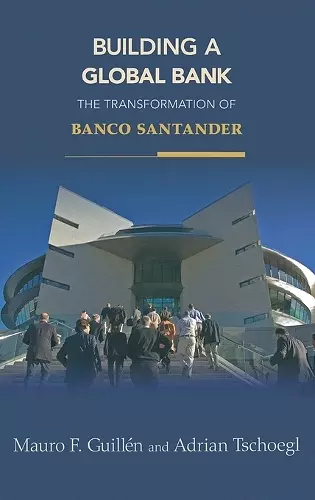Building a Global Bank
The Transformation of Banco Santander
Mauro F Guillén author Adrian Tschoegl author
Format:Hardback
Publisher:Princeton University Press
Published:17th Jun '08
Currently unavailable, and unfortunately no date known when it will be back

Guillen and Tschoegl have a solid grasp of the dynamics of global banking and critically integrate the Santander story into that framework. Santander has had successes and missteps, and will have more of both in the years ahead. This book will leave the reader with an unrivalled observation platform to watch developments as they unfold. -- Ingo Walter, New York University This book tells the story of Banco Santander, one of the most spectacular successes in recent banking history. It makes significant empirical and analytical contributions to the theory of the firm, because it shows how a rather original type of organization can be uniquely nimble and efficient. There is no other comprehensive study of Banco Santander in English or Spanish. -- Gabriel Tortella, Universidad de Alcala
In 2004, Spain's Banco Santander purchased Britain's Abbey National Bank in a deal valued at fifteen billion dollars - an acquisition that made Santander one of the ten largest financial institutions in the world. This work reveals how strategic decisions made by the family drove Santander's unprecedented rise to global prominence.In 2004, Spain's Banco Santander purchased Britain's Abbey National Bank in a deal valued at fifteen billion dollars--an acquisition that made Santander one of the ten largest financial institutions in the world. Here, Mauro Guillen and Adrian Tschoegl tackle the question of how this once-sleepy, family-run provincial bank in a developing economy transformed itself into a financial-services group with more than sixty-six million customers on three continents. Founded 150 years ago in the Spanish port city of the same name, Santander is the only large bank in the world where three successive generations of one family have led top management and the board of directors. But Santander is fully modern. Drawing on rich data and in-depth interviews with family members and managers, Guillen and Tschoegl reveal how strategic decisions by the family and complex political, social, technological, and economic forces drove Santander's unprecedented rise to global prominence. The authors place the bank in this competitive milieu, comparing it with its rivals in Europe and America, and showing how Santander, faced with growing competition in Spain and Europe, sought growth opportunities in Latin America and elsewhere. They also address the complexities of managerial succession and family leadership, and weigh the implications of Santander's stellar rise for the consolidation of European banking. Building a Global Bank tells the fascinating story behind this powerful corporation's remarkable transformation--and of the family behind it.
"[T]he Santander experience is worth reading about and Building a Global Bank offers an excellent opportunity to do so. In addition to archival materials and secondary sources, the authors draw extensively on myriad interviews with financial industry leaders, policymakers, and journalists. In doing so, they write for a general audience and offer an accessible and data-rich institutional history, complete with a detailed ... chronology of the bank's evolution and several citation-filled pages of endnotes."--Joseph M. Santos, EH.net "Guillen and Tschoegl provide an astute analysis of the management style and organizational structure of Santander, focusing on their strategy for internationalization."--Alan M. Rugman, Administrative Science Quarterly "Guillen and Tschoegl have written a well-researched case study."--Jose L. Garcfa-Ruiz, Bankhistorische
ISBN: 9780691131252
Dimensions: unknown
Weight: 539g
280 pages